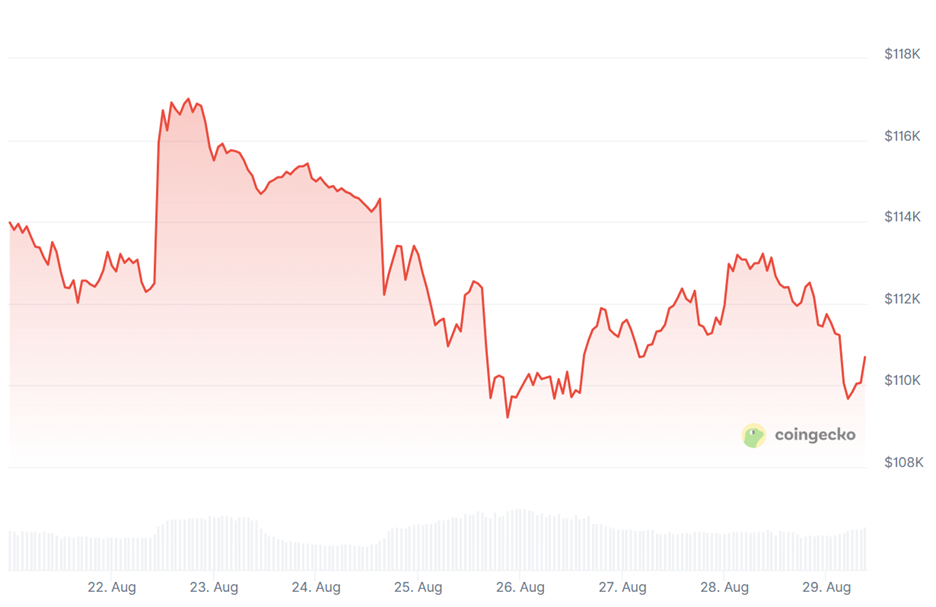 |
| By Juan Villaverde |
Last Friday, all eyes were on Jackson Hole, WY.
That’s where Federal Reserve Chair Jerome Powell gave a wink and a nod to the possibility of an interest rate cut at the Fed’s September meeting.
Almost immediately, markets erupted in an outpouring of exuberant optimism.
Bitcoin (BTC, “A-”) rallied almost 4% within hours.
U.S. stocks surged toward new all-time highs.
Gold spiked.
The dollar plunged.

But the truth is the markets were already itching to cheer no matter what Powell said. Anything short of Powell explicitly ruling out a September cut was likely to ignite a celebration.
That’s because other major central banks have already been cutting interest rates for a good 24 months.
Along the way, gold hit all-time highs. Bitcoin kicked off a two-and-a-half-year bull market. And stocks soared.
All without a Fed cut!
So, just imagine the fireworks we might see when the world’s biggest central bank finally joins the party!
Or at least this is the conventional wisdom. But sometimes these things are not as simple as they may appear.
It’s true looser monetary policy from the Fed — which controls the world’s biggest money-printing machine — would help risk assets soar. At least for a while.
But, as always, the devil is in the details.
Fed Firing
Over the weekend, President Trump “fired” Fed Governor Lisa Cook.
I put “fired” in quotes, because Cook’s lawyer says Trump has no legal “cause” to remove and terminate her. Which means this matter will be ultimately up to the courts.
What caught my eye, though, was how markets reacted, as this drama played out: They tanked.
From $117,000 after Powell’s speech, Bitcoin (BTC, “A-”) plunged to under $110,000 by Tuesday. Which left a lot of investors scratching their heads.

Here’s what happened: Yes, the market wants the Fed to cut rates. Investors are ready to pile in as soon as it happens.
But not if it comes at the expense of the Fed’s perceived independence.
The logic seems clear.
Politicians always want lower rates to put voters in a good mood ahead of the next election … even if too much easy money causes inflation to come roaring back in coming months.
Unlike elected officeholders, markets look well beyond the next election. And if they see inflation rearing its ugly head, any short-term benefits of easier monetary policy can be swiftly undone.
A famous former Fed chair summed it up thusly: “The Fed’s job is to take away the spiked punch bowl … just as the party gets going.”
That’s not popular with politicians. Which is why the markets really love rate cuts only as long as they don’t compromise the Fed’s political independence.
How I know this is what triggered Bitcoin’s sell-off?
Answer: Central Bank Liquidity (CBL). Which has been on the rise since Aug. 4 and only shows a peak in late September.
Bitcoin should be going up during this period, even if only modestly. Instead, it sold off sharply, violating a key low from Aug. 2, as it fell below $110,000 last Monday.
So, while CBL rises … Bitcoin falls. This is the first time that’s happened this cycle.
Let me be clear: I fully expect Bitcoin to resume its uptrend, with the next significant cycle top scheduled for late September.
But not anytime sooner.
This unusual sell-off tied to concerns about Fed independence is something to watch. The market has clearly shown it won’t respond well to this risk.
The Fed’s September Meeting
My Crypto Timing Model says the next key turning point for crypto will be between Sept. 13 and Sept. 20.
And right in the middle of that window — Sept. 17 — Powell is expected to cut rates.
How to interpret this is simple: Over the next few weeks, prices are likely to remain buoyant, fueled by optimism that rate cuts are coming.
But when the moment of truth actually arrives, I expect the market response will be tepid.
Whatever Powell does — or doesn’t do — everything points to this September meeting being a classic “buy the rumor, sell the news” event.
That means we’ll likely see a strong rally into the announcement … followed by prices softening afterward.
That’s how crypto has traded around key announcements for a long time.
As I’ve been saying for weeks now: Expect more summer churn.
And look to Q4 for the big rally we’ve been waiting for.
The Fed’s latest tug of war doesn’t change that outlook.
It just makes positioning your portfolio a little more challenging. But with the stage set for altcoins to outpace Bitcoin, now is the time to do so.
After all, if the alts start to run, it’ll be hard to catch your favorite after the fact.
That’s why my colleague Mark Gough is hosting an urgent crypto briefing this coming Tuesday, Sept. 2 at 2 p.m. Eastern.
In it, he’ll show you how to position yourself to catch this wave. And he’ll talk about the three coins he believes can leave Bitcoin in the dust later this year.
To join him, just RSVP here.
Best,
Juan Villaverde

